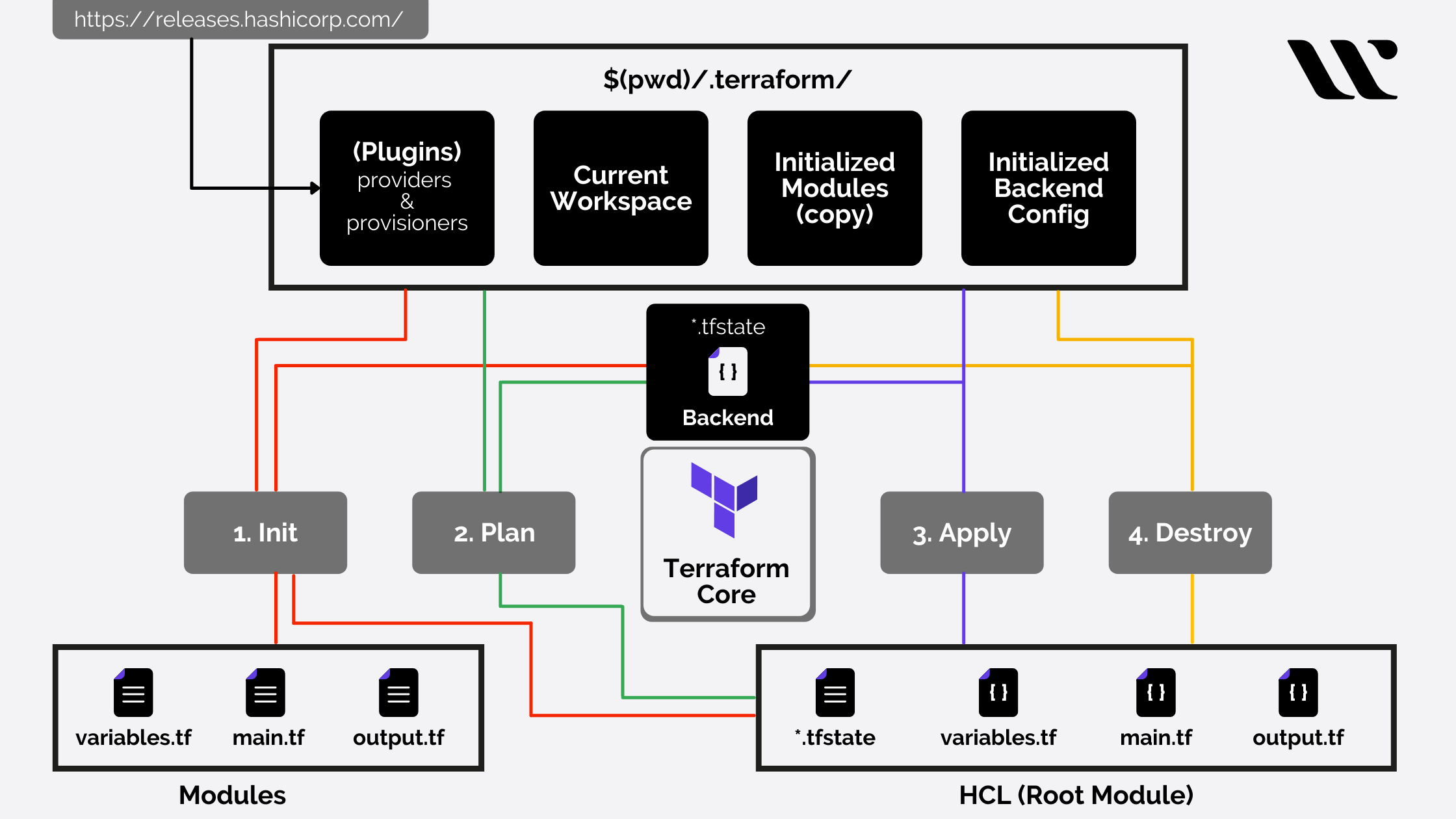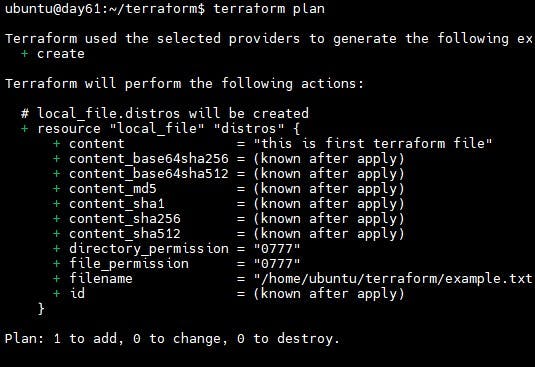Hope you've already got the gist of what working with Terraform would be like. Let's begin with day 2 of Terraform!
Terraform is a robust infrastructure-as-code (IaC) tool for defining and provisioning infrastructure resources across multiple cloud providers. Whether you are new to Terraform or want to extend your knowledge, learning the fundamental commands is critical for a successful infrastructure deployment. In this blog, we will explore basic commands of terraform with examples that will help beginners start working confidently.

Task1:
Terraform init:
The terraform init command is used to configure a working directory with Terraform configuration files. When you run terraform init, Terraform analyzes the configuration directory for the main Terraform files (.tf extension) and downloads the provider plugins and modules needed for your configuration.
Here's a general overview of what happens when you run terraform init:
Terraform examines the configuration directory to identify the main Terraform files (usually with a
.tfextension). These files define the infrastructure resources and their configuration.Terraform initializes a backend, which is responsible for storing Terraform state. The state is used to keep track of the resources managed by Terraform and to plan and apply changes to your infrastructure.
If a backend configuration is not already present, Terraform prompts you to configure one. The backend can be a local file, a remote storage service like Amazon S3 or Azure Blob Storage, or a Terraform Cloud workspace.
Once the backend is configured, Terraform downloads the necessary provider plugins specified in your configuration files. Providers are responsible for managing and interacting with specific infrastructure platforms, such as AWS, Azure, or Google Cloud.
If your configuration references any modules (reusable configurations), Terraform downloads the module source code from the specified module registry or local path.
terraform init

Terraform init -upgrade:
The terraform init -upgrade command is used to initialize a Terraform working directory while also upgrading the installed provider plugins to their latest versions. It performs the same steps as the regular terraform init command, but additionally checks for and downloads any newer versions of the provider plugins.
terraform init -upgrade

Using the -upgrade flag ensures that you are working with the latest versions of the provider plugins, which may include bug fixes, feature enhancements, or other improvements.
Terraform plan:
terraform plan is a command used in Terraform to create an execution plan, will analyze your configuration, determine the changes required to achieve the desired state, and display a summary of those changes. It will also show any new or modified resources, as well as any resources that will be destroyed. It's a best practice to review this plan output to ensure it aligns with your expectations.
terraform plan

You can also specify specific variables on the command line or using variable files if you have complex configurations.
Terraform Apply:
terraform apply is the command in Terraform that actually applies the changes defined in your configuration files to your infrastructure.
Here's what typically happens when you run terraform apply:
Review Plan: If an execution plan was generated, Terraform will present it to you in a human-readable format. This allows you to review the proposed changes before they are applied.
Apply Changes: Once you confirm the execution plan (or if you choose to skip the planning phase), Terraform begins executing the actions necessary to achieve the desired state of your infrastructure. This might involve creating new resources, updating existing ones, or destroying resources that are no longer needed.
Resource Provisioning: Terraform communicates with the underlying infrastructure providers (such as AWS, Azure, or Google Cloud) to provision or modify resources as instructed in your configuration files. Terraform applies changes in the order determined during the planning phase, respecting dependencies between resources.
State Management: Throughout the process, Terraform updates its internal state file (
terraform.tfstateby default) to reflect the changes made to your infrastructure. This state file is crucial for tracking the actual state of your infrastructure and determining future changes.Output: Finally, Terraform provides a summary of the changes it made, including any resources that were created, updated, or destroyed. It also reports any errors or warnings encountered during the process.
terraform apply
Terraform validate:
terraform validatecommand is used in Terraform to check whether the configuration files in your Terraform project are syntactically valid and internally consistent. When you run this command, Terraform parses the configuration files (usually written in HashiCorp Configuration Language, or HCL) and performs a basic validation to ensure that they adhere to the expected format and structure.terraform validate
By running this command
terraform validate, you can catch many common errors in your Terraform configuration files early in the development process, before attempting to apply changes to your infrastructure. This helps ensure that your configuration is well-formed and ready for further testing or deployment.Terraform fmt:
terraform fmtcommand is used in Terraform to automatically format your Terraform configuration files according to a standard style. When you run this command, Terraform rewrites your configuration files to ensure consistent formatting throughout, making them easier to read and maintain.terraform fmtBy running
terraform fmtregularly as part of your development workflow, you can ensure that your Terraform codebase maintains a consistent style, making it easier to review, modify, and maintain over time. This command helps enforce best practices for code formatting and contributes to overall code quality.Terraform destroy:
The
terraform destroycommand is used to destroy the infrastructure created by your Terraform configuration. It removes all the resources managed by Terraform, effectively reverting your infrastructure to its pre-deployment state.To use
terraform destroy, here are the steps:Open a command prompt or terminal and navigate to the directory containing your Terraform configuration files.
Run the
terraform initcommand to initialize the working directory if you haven't done so already:
terraform init
- Run the
terraform destroycommand to initiate the destruction process:
terraform destroy

Terraform will analyze the state of your infrastructure based on the Terraform state file and plan the necessary actions to destroy the resources.
Terraform will display a summary of the resources that will be destroyed. Review the list to ensure it matches your expectations.
It's important to note that the
terraform destroycommand irreversibly removes the resources, so use it with caution. Make sure you have a backup or a way to restore your infrastructure if needed.Terraform's competitors:
Terraform is a popular infrastructure as code (IaC) tool, but there are several other tools in the IaC ecosystem that serve similar purposes. Here are some of Terraform's competitors:
AWS CloudFormation:
Provider: Primarily used for managing AWS resources.
Language: JSON or YAML templates.
Integration: Native integration with AWS services.
Azure Resource Manager (ARM) Templates:
Provider: Used for managing Azure resources.
Language: JSON templates.
Integration: Native integration with Azure services.
Google Cloud Deployment Manager:
Provider: Used for managing resources on Google Cloud Platform (GCP).
Language: YAML or Jinja templates.
Integration: Native integration with GCP services.
Ansible:
Provider: Supports multiple cloud providers and on-premises infrastructure.
Language: YAML-based playbooks.
Focus: Not only for infrastructure provisioning but also for configuration management and automation.
Chef:
Provider: Focus on configuration management but can be used for infrastructure automation.
Language: Ruby-based DSL (Domain-Specific Language).
Focus: Configuration management and automation.
SaltStack:
Provider: Similar to Chef, used for configuration management and automation.
Language: YAML and Python.
Focus: Configuration management and automation.
These are just a few examples of Terraform commands. The full list of commands and their options can be found in the Terraform documentation or by running terraform --help in your terminal. Each command serves a specific purpose in managing your infrastructure as code with Terraform.
Thank you for 📖reading my blog, 👍Like it and share it 🔄 with your friends .Hope you find it helpful🤞
Happy learning😊😊